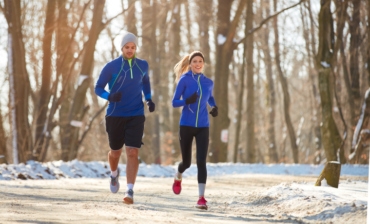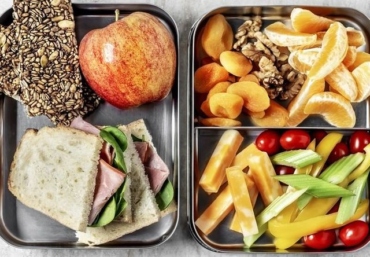Going for a run can be an intimidating prospect in the best of weather. Living in Canada, we are obviously faced with at least a few months of “less than ideal” outdoor running conditions. In this article I am going to discuss running safely and effectively in the winter months.
First we are going to put to rest a winter running myth. You are not going to freeze your lungs if you run in the winter! By the time the cold air hits your lungs it has warmed up. I have run in some very cold weather and lived to tell about it. So no excuses!
The key to having a successful run in the winter is having the proper gear. In the winter, it’s all about layering. We will walk through how to layer up and still be able to move for your run.
The trick to determining how much to wear when heading out for a brisk winter run is to add 10 degrees to the outdoor temperature and dress for that temperature. This represents your body temperature, and so it is how you should dress. Also, taking note of how cold it was outside, what you wore and how you felt on the run is a good habit to form so you have a better idea of what to wear. You should feel a little cold at the beginning of the run then as you start working harder, your body will heat up to a point where you should be comfortable.
For your upper body the first layer should be tight-fitting and moisture-wicking. Not cotton…cotton is rotten and will stay wet when you sweat. The second layer is one you can play around with to best suit the temperature: a T-shirt, a looser fitting dry fit or even a sweatshirt if it is very cold. The last layer I recommend is a jacket that is going to cut the wind. If you have something that gets rid of the wind chill, it will make a big difference.
On your lower body, you definitely want to be in pants — Spandex, yoga style or even a nylon pant will do, just make sure you can move in them. You can put a second layer on your lower body when it’s really cold. I usually always wear at least tight shorts under my pants.
Be sure to cover your hands and ears as well. Your extremities will get especially cold in a colder temperature. Proper gloves and a toque or headband are an absolute must. It may also be warranted to get some warmer winter running socks to keep your toes warm.
Now that you are dressed and ready to take on the great outdoors, another thing you need to consider is the slippery conditions of the sidewalk. Ice can be hard to spot, so make sure to watch out for it. Try to avoid routes that not well kept and potentially very icy. And if this is not avoidable, run with a wider stance and slower pace as this is more stable.
Since it’s cold outside, it’s important to ease into your run — or better yet, do a warm up pre-run. You do not want to step outside and start out at a fast pace, as your muscles will be cold. So start off easy and let your muscles warm up. Then you can increase your pace.
Another thing to consider with winter running is the lack of daylight. Be sure to have something that lights up or is reflective on while running in these conditions. Also be sure to check before crossing roads because you are harder to see in the dark.
A few local areas that I have found that are well maintained throughout the winter are the Lakeshore trail and Mount Pleasant Cemetery.
If you absolutely must do a run on the treadmill due to a blizzard…this is the only acceptable circumstance. Put the incline to 1.0 — this makes the effort level more comparable to outdoor running.
Lastly, set a spring time goal! It’s really hard to stay motivated in the winter, so I advise everyone to sign up for a race in the spring time. That way you have to keep training and running through the winter months. There are a lot of great races in the Toronto area in the spring, so check them out. All this winter running makes you way tougher for these spring races.
See you out on the roads….Stay warm and happy running!



 It’s important to eat a good breakfast daily. Aim to consume 20-25% of your daily calories at breakfast to keep you fuelled longer and help ward off evening eating excess. On days when you are not training first thing, try swapping out the oatmeal for some eggs and handful of nuts. Or have a protein rich smoothie with veggies, 1/2 an avocado and only 1 cup of fruit. Proteins and fats will give your body long lasting energy and make you feel more satisfied and reduce cravings later on in the day. If you are training first thing in the morning, easy to digest carbs are the way to go, as they digest quickly so you can get on with your workout.
It’s important to eat a good breakfast daily. Aim to consume 20-25% of your daily calories at breakfast to keep you fuelled longer and help ward off evening eating excess. On days when you are not training first thing, try swapping out the oatmeal for some eggs and handful of nuts. Or have a protein rich smoothie with veggies, 1/2 an avocado and only 1 cup of fruit. Proteins and fats will give your body long lasting energy and make you feel more satisfied and reduce cravings later on in the day. If you are training first thing in the morning, easy to digest carbs are the way to go, as they digest quickly so you can get on with your workout.
